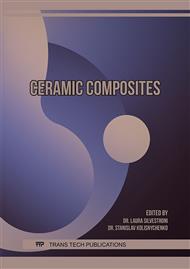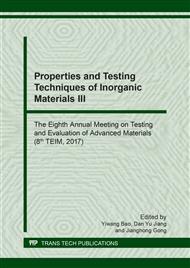[1]
Y.Q. Tan, L. Heng, H.B. Zhang, et al. Fabrication of toughened B4C ceramics with high electrical conductivity using MAX phase as a novel sintering aid, J. Ceram. Int. 42(6) (2016) 7347-7352.
DOI: 10.1016/j.ceramint.2016.01.133
Google Scholar
[2]
P. He, S.M. Dong, Y.M. Kan, et al. Microstructure and mechanical properties of B4C-TiB2 ceramics prepared by reaction hot pressing using Ti3SiC2 as additive, J. Ceram. Int. 42(1) (2015) 650-656.
DOI: 10.1016/j.ceramint.2015.08.160
Google Scholar
[3]
B.M. Moshtaghioun, D.G. García, A. Domínguez-Rodríguez. High-temperature plastic deformation of spark plasma sintered boron carbide-based ceramics: The case study of B4C-SiC with/without graphite (g), J. J. Eur. Ceram. Soc. 36(5) (2016) 1127-1134.
DOI: 10.1016/j.jeurceramsoc.2015.12.016
Google Scholar
[4]
R.J. He, Z.L. Zhou, Z.L. Qu, et al. High temperature bending strength and oxidation behavior of hot-pressed B4C-ZrB2 ceramics with various ZrB2 contents at 1000-1600 °C in air, J. Int. J. Refract. Met. Hard Mater. 57 (2016) 125-133.
DOI: 10.1016/j.ijrmhm.2016.03.005
Google Scholar
[5]
J.L. Wang, W.S. Lin, Z.W. Jiang, et al. The preparation and properties of SiCw/B4C ceramics infiltrated with molten silicon, J. Ceram. Int. 40(5) (2014) 6793-6798.
DOI: 10.1016/j.ceramint.2013.12.003
Google Scholar
[6]
A. Thuault, S. Marinel, E. Savary, et al. Processing of reaction-bonded B4C-SiC ceramics in a single-mode microwave cavity, J. Ceram. Int. 39(2) (2013) 1215-1219.
DOI: 10.1016/j.ceramint.2012.07.047
Google Scholar
[7]
P. Barick, D.C. Jana, N. Thiyagarajan. Effect of particle size on the mechanical properties of reaction bonded boron carbide ceramics, J. Ceram. Int. 39(1) (2013) 763-770.
DOI: 10.1016/j.ceramint.2012.06.089
Google Scholar
[8]
P.Y. Huang. Powder Metallurgy Principle, M. Beijing: Metallurgical Industry Press (1997) 173-195.
Google Scholar
[9]
J.E. Hilliard, J.W. Cahn. An evaluation of procedures in quantitative metallography for volume-fraction analysis, J. Trans. Metall. Soc. AIME, 221 (1961) 344-352.
Google Scholar
[10]
A.L. Yurkov, B.S. Skidan, A.B. Ponomarev. Reaction between boron carbide and silicon, J. Refractories, 28(1) (1987) 90-92.
DOI: 10.1007/bf01386737
Google Scholar
[11]
Z.F. Chen, Y.B. Su, Y.B. Cheng. Formation and sintering mechanisms of reaction bonded silicon carbide-boron carbide ceramics, J. Key Eng. Mater. 352 (2007) 207-212.
DOI: 10.4028/www.scientific.net/kem.352.207
Google Scholar
[12]
C.P. Zhang, H.Q. Ru, W. Wang, et al. The role of infiltration temperature in the reaction bonding of boron carbide by silicon infiltration, J. J. Am. Ceram. Soc. 97(10) (2014) 3286-3293.
DOI: 10.1111/jace.13085
Google Scholar
[13]
A.L. Yurkov, A.M. Starchenko, B.S. Skidan. Reaction sintering of boron carbide, J. Refractories, 30(11-12) (1989) 731-736.
DOI: 10.1007/bf01288282
Google Scholar
[14]
W.D. Callister, D.G. Rethwisch. Materials science and engineering: an introduction, M. New York: John Wiley & Sons, Inc. (2007) 412-606.
Google Scholar
[15]
S. Hayun, M.P. Darie, N. Frage, et al. The high-strain-rate dynamic response of boron carbide-based ceramics: The effect of microstructure, J. Acta Mater. 58(5) (2010) 1721-1731.
DOI: 10.1016/j.actamat.2009.11.014
Google Scholar
[16]
U. Engel, H. Hubner. Strength improvement of cemented carbides by hot isostatic pressing, J. J.Mater. Sci. 13(9)(1978) 2003-(2012).
DOI: 10.1007/bf00552908
Google Scholar
[17]
P. Jannotti, G. Subhash, J. Zheng, et al. Measurement of microscale residual stresses in multi- phase ceramic composites using Raman spectroscopy, Acta Mater. 129 (2017) 482-491.
DOI: 10.1016/j.actamat.2017.03.015
Google Scholar
[18]
F. Thevenot. Boron carbide-A comprehensive review, J. J. Eur. Ceram. Soc. 6(4) (1990) 205-225.
Google Scholar
[19]
N.E. Dowling. Mechanical behavior of materials: engineering methods for deformation, fracture, and fatigue M. Upper Saddle River: Pearson Education, Inc. (2007) 152-154.
Google Scholar
[20]
M.W. Barsoum. Fundamentals of Ceramics M. New York: The McGraw-Hill Companies Inc (1997) 201-205.
Google Scholar
[21]
S.R. Choi, W.A. Sanders, J.A. Salem, et al. Young's modulus, strength and fracture toughness as a function of density of in situ toughened silicon nitride with 4 wt% scandia, J. J. Mater. Sci. Lett. 14(4) (1995) 276-278.
DOI: 10.1007/bf00275622
Google Scholar
[22]
R. Chaim, M. Hefetz. Effect of grain size on elastic modulus and hardness of nanocrystalline ZrO2-3 wt%Y2O3 ceramic, J. J. Mater. Sci. 39(9) (2004) 3057-3061.
DOI: 10.1023/b:jmsc.0000025832.93840.b0
Google Scholar
[23]
S. Hayun, H. Dilman, M.P. Dariel, et al. The effect of carbon source on the microstructure and the mechanical properties of reaction bonded boron carbide, J. Adv. Sinter. Sci. Technol. Ceram. Trans. (2010) 27-39.
DOI: 10.1002/9780470599730.ch4
Google Scholar
[24]
A.S. Namini, S.N.S. Gogani, M.S. Asl, et al. Microstructural development and mechanical properties of hot pressed SiC reinforced TiB2 based ceramic, J. Int. J. Refract. Met. Hard Mater. 51 (2015) 169-179.
DOI: 10.1016/j.ijrmhm.2015.03.014
Google Scholar
[25]
S. Hayun, H. Dilman, M.P. Dariel, et al. The effect of aluminum on the microstructure and phase composition of boron carbide infiltrated with silicon, J. Mater. Chem. Phys. 118(2) (2009) 490-495.
DOI: 10.1016/j.matchemphys.2009.08.023
Google Scholar



